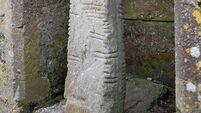Salvage operation starts as divers set to inspect yacht
The powerful Ocean Bank tug, skippered by Sean Harrington from Bere Island in West Cork, established a tow on the 100ft capsized yacht where it was found drifting some 6.5km from the Fastnet Rock around 2pm.
A heavy swell prevented divers from conducting a detailed inspection of the vessel and a decision was taken to tow it to a cove near Brow Head.













